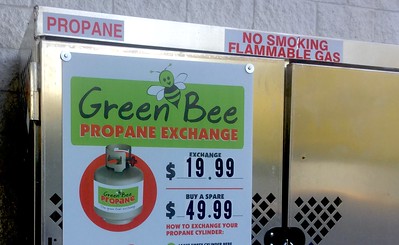
Filling propane tanks by weight is important because it’s the most accurate way to know how much propane is in the tank. It can change its volume with temperature – it expands when it’s warm and shrinks when it’s cold. This means if you measure by volume, the amount might seem different depending on the weather, but the actual amount of propane doesn’t change.
When you fill a tank by this method, you’re getting a precise measure of how much gas is inside, no matter if it’s hot or cold outside. Each has a maximum weight limit for safety, doing so makes sure you don’t overfill the tank, which can be dangerous.
Weight measurement offers a consistent and reliable method for filling tanks. This consistency is crucial for both safety and efficiency. When it is filled by this method, you can be sure that it contains the right amount of propane, ensuring optimal performance of your propane-powered appliances.
On the other hand, filling by volume can be tricky. The volume of gas can vary significantly with temperature changes. For instance, on a hot day, the propane in the tank can expand, taking up more space. This could give a false impression that the tank is more full than it actually is. Conversely, in colder weather, the gas contracts, appearing to be less than what’s actually in the tank.
This variability in volume can lead to situations where you either get less propane than you paid for, or worse, overfilling the tank which is a safety hazard. Overfilling can cause excessive pressure in the tank, potentially leading to leaks or even a rupture.
Therefore, filling through this method not only provides a more accurate measure of the propane you’re getting but also ensures the safety of the operation. It’s a straightforward method that helps avoid the risks associated with the temperature-dependent expansion and contraction of the gas.
Understanding Weight Specifications
Understanding the specifications of a tank is crucial for safe and effective use. Here’s a breakdown of the key concepts:
Tare Weight (TW)
- Definition: The TW is the weight of the empty cylinder. This doesn’t include any gas inside.
- Purpose: Knowing the TW is essential for determining how much gas can be safely added to the bottle.
Total Weight Limits
- Gross Weight: This is the combined weight of the tank when it’s full of propane. It includes the TW plus the weight of the propane itself.
- Maximum Limit: Each cylinder has a maximum safe weight limit, which is the TW plus the maximum allowable weight of propane. Exceeding this limit can be dangerous.
Reading Weight Specifications
- Location of Information: The specifications, including the TW, are usually stamped on the collar or handle of the tank.
- Understanding the Numbers: For example, if it has a TW of 17 pounds and can hold 20 pounds of propane, its gross weight when full should be around 37 pounds (17 pounds TW + 20 pounds of propane).
- Safety Margin: Always leave a little margin for safety. It’s better not to fill the tank to its absolute maximum capacity.
Importance of Adherence
- Overfilling Risks: Filling beyond the maximum limit can lead to increased pressure inside the tank, potentially causing leaks or even rupture.
- Underfilling: While less dangerous than overfilling, underfilling means you might not have enough propane when you need it, which can be inconvenient.
Understanding and adhering to the specifications of a cylinder is vital for safety and efficiency. Always check these details before filling a tank, and if in doubt, consult a professional.
Determine the TW of the Propane Cylinder When Filling
The TW of a cylinder is typically marked on the tank itself. It represents the empty weight of the cylinder without any gas in it. The TW is an important value to know because it’s used to calculate how much propane can be safely added to it.
To determine the TW of a specific cylinder when filling it, you should look for the TW information on the on collar or handle. It is usually stamped or engraved on a metal plate or directly onto the tank. The TW is often expressed in pounds (lbs) or kilograms (kg) depending on the region.
Once you locate the TW , you can use it in the following formula to calculate the maximum safe capacity:
Propane Capacity=Gross Weight Limit−Tare WeightPropane Capacity=Gross Weight Limit−Tare WeightHere, the Gross Weight Limit is the maximum weight the tank can safely hold when full of propane. It’s important not to exceed this limit to ensure safe operation of the cylinder.
Remember to always refer to the manufacturer’s guidelines and safety recommendations for the specific cylinder you are using, as different cylinders may have different TW and capacity specifications.
Determine the Weight of a Propane Tank when Full
Multiply the water capacity (W.C.) stamped on the collar of the tank by .42. And then add the TW. This will then give the accurate weight of the tank when it is full of gas.
When determining the weight of a tank when full, it is important to consider the size and type of cylinder being used. When it comes to determining the weight of a tank, there are a few things that you need to take into account. The first is the size of the cylinder. The larger, the more propane it will hold and therefore the heavier it will be. The second thing to consider is how full the bottle is.
A full cylinder will weigh more than an empty one. Finally, you need to factor in the weight of the gas itself. This will vary depending on the type of gas, but gas typically weighs about 4.2lbs per gallon. Putting all of this together, we can estimate that a standard 20lb tank will weigh around 87lbs when full. Of course, this is just an estimate and your actual mileage may vary!
How Do You Fill a Propane Tank By Weight?
If you want to fill by weight, you’ll need to first find out how much gas your tank can hold. This information should be listed on the tank itself. Once you know the capacity, you can determine how much gas you need to fill it. To do this, simply weigh the empty tank and then subtract the weight of the full tank from the weight of the empty tank. This will give you the weight of the gas that your bottle can hold. From there, you can determine how much gas you need to fill it by weight.
If you’re filling by weight, there are a few things you need to know. First, you’ll need to find a scale that can accommodate the size of your tank. Second, you’ll need to determine the TW of your tank. Once you know the TW, you can determine how much gas to add by subtracting the TW from the total weight of the filled tank.
Preparation
- Safety First: Working in a well-ventilated area reduces the risk of gas accumulation, and keeping away from flames or sparks is crucial because propane is highly flammable. Wearing gloves protects your hands from the cold metal of the tank, and safety glasses protect your eyes.
- Check the Tank: Examining it for damage is important for safety. Dents, rust, or cracks can be signs of potential leaks or weaknesses in its structure.
2. Find the TW
- Locate the TW: It is essential for calculating how much gas to add. It’s usually stamped on a metal part of the tank.
- Understand the Capacity: Knowing the TW helps determine the maximum amount of propane that can be safely added to the tank, preventing overfilling.
3. Set Up the Scale
- Use a Proper Scale: The scale should be able to accurately measure the weight of the full tank. It should be regularly calibrated to ensure accuracy.
- Position the Tank: It needs to be stable on the scale to get a correct reading. Any movement can lead to inaccurate measurement.
4. Begin Filling
- Attach the Hose: This step involves securely connecting the filling hose to the tank. A secure connection prevents leaks during filling.
- Monitor the Scale: Watch the scale closely as you fill. This is how you’ll know when you’ve added the right amount of propane.
5. Stop at the Right Weight
- Know the Limit: You need to stop filling when the weight indicated on the scale equals the TW plus the propane capacity. This prevents overfilling.
- Disconnect Safely: Turning off the valve first and then disconnecting the hose reduces the risk of propane escaping.
6. Final Checks
- Leak Test: Applying soapy water around the valve and connection points and looking for bubbles helps identify any leaks.
- Secure the Valve: Ensuring the valve is closed and capped prevents any accidental gas release.
7. Safety and Accuracy Tips
- Regular Calibration: Keeping your scale accurate is key to ensuring you’re not underfilling or overfilling the tank.
- Never Overfill: Overfilling it can be dangerous as it leaves no room for the propane to expand, which can lead to increased pressure and potential hazards.
Why is Weighing the Cylinder an Important Part of the Requalification Process?
Weighing the cylinder is an important part of the cylinder requalification process for two reasons:
- It allows us to determine the TW of the cylinder. This information is important because it allows us to calculate the net weight of gas that can be stored in the cylinder.
- It also allows us to verify that the cylinder meets the minimum weight requirements set by the Department of Transportation (DOT). Cylinders that do not meet the minimum DOT requirements are not allowed to be used for storage or transportation of hazardous materials.
- Weighing the cylinder is an important part of the requalification process because it provides a means of checking the cylinder’s contents. A properly working scale will display the weight of the cylinder, allowing the user to confirm that the correct amount of gas is inside. This is a crucial safety check, as improper amounts of gas can be dangerous.
- Additionally, weighed cylinders can be used to track how much product has been used over time, providing valuable information for businesses.
Do Propane Tanks Need to be Emptied Before Refill?
If you have a tank that needs to be refilled, you may be wondering if you need to empty it first. The answer is no, you do not need to empty your propane tank before refill. In fact, it is best to leave a little bit of propane in the tank so that the pressure is not too low when you go to refill it.
You can actually refill it at any time, regardless of how much fuel is left in it. In fact, many people choose to refill their cylinders when they’re only half full, so they never have to worry about running out of propane.
Refilling the bottle is safe even if it’s not empty. The process adds more propane to it. Just be cautious not to overfill it. If you ever smell gas or suspect a leak, stop using it immediately and seek assistance for safety.
You can top up a cylinder anytime, even if it’s not empty. No need to wait for it to run out. But remember, don’t overfill it, and always be safe. If you ever smell gas or think there’s a leak, stop using it and get help right away to stay safe.
How to Determine the Propane Left in the Tank?
To determine the amount of propane left in a tank by weighing it, follow these steps:
- Find the TW: Locate the TW. It is stamped on the collar.
- Weigh the Tank: Using a suitable scale, weigh the entire cylinder, including the valve and all fittings. Make sure the tank is upright during the weighing process.
- Calculate the Weight: Subtract the TW from the total weight obtained in step 2. The result is the weight of the propane inside the tank.
- Compare to Capacity: Refer to the specifications to determine its maximum propane capacity, usually in pounds or kilograms.
- If the weight of the gas is well below its maximum capacity, you have propane left.
- If the weight is close to or at the maximum capacity, consider refilling soon.
This method provides an accurate measurement of the propane remaining in the tank and is particularly useful when it doesn’t have a built-in gauge or when you want to ensure precise monitoring of propane levels. Always exercise caution when handling propane and tanks, and follow safety guidelines.
Will You Choose This Method of Filling
Choosing to fill your propane tank by weight is a wise decision. It offers you a precise way to know how much gas you have left and ensures you’re always prepared for your propane needs. It’s a safe and efficient method that allows you to enjoy your propane-powered activities with confidence. Whether it’s grilling, heating, or any other use, filling by weight simplifies the process and enhances your overall propane experience. So, go ahead and choose this method to make your propane management hassle-free and convenient!
By opting for the method of filling your tank by weight, you are taking a practical step towards better propane management. This approach offers you the peace of mind of knowing exactly how much propane is available for your various needs. Whether you’re planning a barbecue, heating your home, or using propane for any purpose, filling by weight ensures you won’t run out unexpectedly.
Moreover, it’s a safe and straightforward method that minimizes the risk of overfilling and potential hazards. You can confidently enjoy your propane-powered moments, knowing that you have a reliable way to gauge your propane supply.
So, continue to use this method, and you’ll find it to be a convenient and efficient way to keep your propane tank in check and ready for any occasion.
When Filling Cylinders It Is Important to Know These Factors
- Total Weight of the Cylinder: This refers to the combined weight of everything in and on the propane cylinder. It includes the weight of the gas inside the cylinder, the weight of the cylinder itself (which is typically made of steel), and any additional fittings or accessories attached to the tank, such as regulators or hoses.
- Density of the Gas: The density of the gas (propane, in this case) is a measure of how much mass it has in a given volume. It affects how much gas can fit inside the cylinder at a specific weight. The gas has a higher density compared to air, which is why it’s stored as a compressed liquid in the cylinder.
- Temperature of the Gas: The temperature of the gas plays a significant role in its density. As the temperature changes, the gas can expand (get less dense) or contract (get more dense). This, in turn, affects the amount of gas that is in the cylinder at a given weight. Higher temperatures lead to gas expansion, while lower temperatures cause contraction.
- Pressure of the Gas: The pressure of the gas inside the cylinder is directly related to how much gas is expelled from the cylinder when it’s in use. When you open the valve on the tank, the pressure difference between the inside of the tank and the outside atmosphere causes the gas to flow through the system.
- TW: It’s an important value to know because it’s used to calculate the net weight of the gas inside the tank. The TW is typically stamped on the tank and is used to determine the capacity.
- Gross Weight: The gross weight is the weight of it when it’s completely full of propane. This includes the TW plus the weight of the propane itself. It’s important not to exceed this weight to prevent overfilling, which can be dangerous.
- Net Weight of the Contents: This is the actual weight of the gas inside the tank. It’s calculated by subtracting the TW from the gross weight. The net weight is what you’re interested in to determine how much gas is left in it.
- Density of Propane: This is a property of propane that tells us how much gas can be stored in a given volume. It’s important to understand because it helps determine how much gas can fit in the tank and how it behaves under different temperature and pressure conditions.
Common Mistakes to Avoid When Filling
| Common Mistakes | Avoidance Tips |
|---|---|
| Not Checking the TW | Always check the TW stamped on the tank before filling. |
| Using an Inaccurate Scale | Regularly calibrate your scale and ensure it’s capable of handling the weight of a full propane tank. |
| Overfilling the Tank | Stop filling when the combined weight of the propane and the tank reaches the limit. |
| Ignoring Temperature Effects | Be mindful of the ambient temperature and understand that propane expands and contracts with temperature changes. |
| Neglecting Safety Precautions | Always wear protective gloves and glasses, and fill the tank in a well-ventilated area. |
| Not Performing a Leak Test | After filling, apply soapy water around the valve. Bubbles indicate a leak. |
| Improper Tank Handling | Handle the tank gently. Ensure it’s upright and stable during transport and filling. |
| Ignoring Tank Condition | Regularly inspect your tank for any signs of wear or damage. Replace it if necessary. |
| Filling in Unsafe Locations | Choose a safe location away from ignition sources and ensure good ventilation. |
| Rushing the Process | Take your time. Ensure each step is done carefully and correctly. |
To Make a Conclusion
Filling a propane tank by weight is a smart way to know how much gas is inside, so you’re ready for grilling, heating, or whatever you need. It’s about keeping things safe and efficient.
This method helps you stay in control of your propane and make sure you have enough when you need it. So, whether you’re barbecuing or staying warm, filling by weight keeps things simple and safe. Just weigh, fill, and enjoy your propane-powered moments!
In simple terms, filling a tank by weight is like knowing how much gas is left in your car before a road trip. It ensures you’re prepared for all your propane needs, whether it’s grilling a tasty meal or staying warm in winter. So, remember to weigh, fill, and enjoy your propane adventures without worries!
Just remember, to weigh the tank, be careful not to overfill, and stay safe with your propane!

Mike is an experienced propane technician with over 15 years of professional experience in the field. He has dedicated his career to helping customers with their propane needs, from installation to maintenance and repair. Together with Jeremy, he co-founded this website to provide useful information and guidance to customers seeking reliable propane services.



